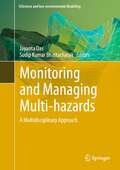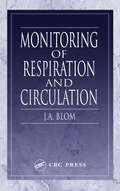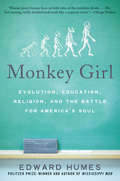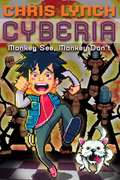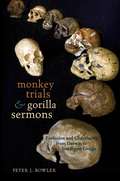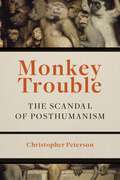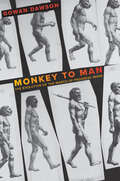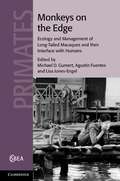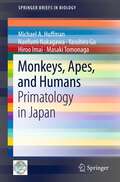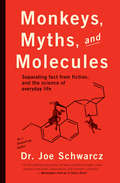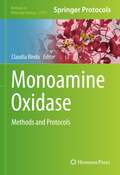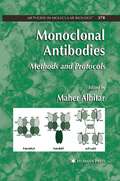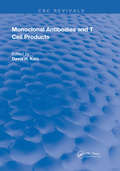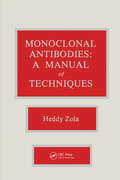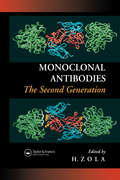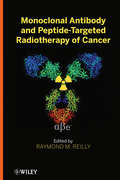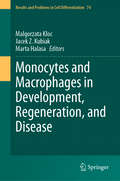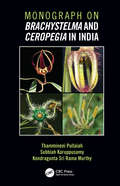- Table View
- List View
Monitoring and Managing Multi-hazards: A Multidisciplinary Approach (GIScience and Geo-environmental Modelling)
by Jayanta Das Sudip Kumar BhattacharyaTo monitor multi-hazards, Remote Sensing and GIS-based multi-criteria decision-making (MCDM) techniques have been extensively used in recent years worldwide. Since natural hazards cannot be eliminated, only quantification of these events and reliable forecasting can alleviate their detrimental effects, through which we can build more resilient and safe societies. Moreover, cultivating the proper knowledge of the multi-hazards and their monitoring and management can fill the gap between science, policy, and the community concerned. In an endeavor to understand and characterize the various hazards, Monitoring and Managing Multi-hazards: A Multidisciplinary approach presents a synthesis of what cross-disciplinary researchers know about these hazards and indigenous adaptation strategies.The book therefore focuses on the use of precision techniques, Remote Sensing, and GIS technologies to quantify various natural, environmental and social hazards along with the capacity building and sustainable mitigation strategies towards resilient societies. It encompasses both thematic and regional case studies to highlight the dynamicity of climate change, change of natural resources, landscape, water, river, agricultural, and social ecosystems at various spatio-temporal scales, including theoretical and applied aspects. The book gives readers an overview and analysis of traditional and advanced geospatial technologies on atmospheric, lithospheric, hydrosphere, biospheric and socio-economic contexts, on all spatial and temporal scales regarding hazards and disasters and sustainable development and management for the future.
Monitoring of Respiration and Circulation
by J. A. BlomMonitoring of Respiration and Circulation provides biomedical engineers with a comprehensive source for understanding the variables of the respiratory and circulatory systems, which indicate how well these systems are functioning. This book covers techniques for measuring the variables, including modeling, medical instrumentation, and signal proces
Monkey Girl
by Edward HumesWhat should we teach our children about where we come from? Is evolution a lie or good science? Is it incompatible with faith? Have scientists really detected evidence of a creator in nature? From bestselling, Pulitzer Prize-winning author Edward Humes comes a dramatic story of faith, science, and courage unlike any since the famous Scopes Monkey Trial. Monkey Girl takes you behind the scenes of the recent war on evolution in Dover, Pennsylvania, when the town's school board decision to confront the controversy head-on thrust its students, then the entire community, onto the front lines of America's culture wars. Told from the perspectives of all sides of the battle, it is a riveting true story about an epic court case on the teaching of "intelligent design," and what happens when science and religion collide.
Monkey GirlEvolution, Education, Religion, and the Battle for America's Soul
by Edward HumesWhat should we teach our children about where we come from? Is evolution a lie or good science? Is it incompatible with faith? Have scientists really detected evidence of a creator in nature? From bestselling, Pulitzer Prize-winning author Edward Humes comes a dramatic story of faith, science, and courage unlike any since the famous Scopes Monkey Trial. Monkey Girl takes you behind the scenes of the recent war on evolution in Dover, Pennsylvania, when the town's school board decision to confront the controversy head-on thrust its students, then the entire community, onto the front lines of America's culture wars. Told from the perspectives of all sides of the battle, it is a riveting true story about an epic court case on the teaching of "intelligent design," and what happens when science and religion collide.
Monkey See, Monkey Don't (Cyberia #2)
by Chris LynchZane has made an enemy for life in the evil Dr. Gristle, who is jealous of Zane's ability to use technology to talk to animals. He's now working on a new device to control animals' movement and speech--and Zane's dog is one of the first test cases.
Monkey Trials and Gorilla Sermons: Evolution and Christianity from Darwin to Intelligent Design (New Histories of Science, Technology, and Medicine)
by Peter J. BowlerFrom the beginning, Darwin’s dangerous idea has been a snake in the garden, denounced from pulpits then and now as incompatible with the central tenets of Christian faith. Recovered here is the less well-known but equally long history of thoughtful engagement and compromise on the part of liberal theologians. Peter J. Bowler doesn’t minimize the hostility of many of the faithful toward evolution, but he reveals the existence of a long tradition within the churches that sought to reconcile Christian beliefs with evolution by finding reflections of the divine in scientific explanations for the origin of life. By tracing the historical forerunners of these rival Christian responses, Bowler provides a valuable alternative to accounts that stress only the escalating confrontation. Our polarized society, Bowler says, has all too often projected its rivalries onto the past, concealing the efforts by both scientists and theologians to find common ground. Our perception of past confrontations has been shaped by an oversimplified model of a “war” between science and religion. By uncovering the complexity of the debates sparked by Darwin’s theory, we might discover ways to depolarize our own debates about where we came from and why we are here.
Monkey Trouble: The Scandal of Posthumanism
by Christopher PetersonAccording to scholars of the nonhuman turn, the scandal of theory lies in its failure to decenter the human. The real scandal, however, is that we keep trying.The human has become a conspicuous blind spot for many theorists seeking to extend hospitality to animals, plants, and even insentient things. The displacement of the human is essential and urgent, yet given the humanist presumption that animals lack a number of allegedly unique human capacities, such as language, reason, and awareness of mortality, we ought to remain cautious about laying claim to any power to eradicate anthropocentrism altogether. Such a power risks becoming yet another self-accredited capacity thanks to which the human reaffirms its sovereignty through its supposed erasure.Monkey Trouble argues that the turn toward immanence in contemporary posthumanism promotes a cosmocracy that absolves one from engaging in those discriminatory decisions that condition hospitality as such. Engaging with recent theoretical developments in speculative realism and object-oriented ontology, as well as ape and parrot language studies, the book offers close readings of literary works by J.M. Coetzee, Charles Chesnutt, and Walt Whitman and films by Alfonso Cuarón and Lars von Trier.Anthropocentrism, Peterson argues, cannot be displaced through a logic of reversal that elevates immanence above transcendence, horizontality over verticality. This decentering must cultivate instead a human/nonhuman relationality that affirms the immanent transcendency spawned by our phantasmatic humanness.
Monkey to Man: The Evolution of the March of Progress Image
by Gowan DawsonThe first book to examine the iconic depiction of evolution, the &“march of progress,&” and its role in shaping our understanding of how humans evolved We are all familiar with the &“march of progress,&” the representation of evolution that depicts a series of apelike creatures becoming progressively taller and more erect before finally reaching the upright human form. Its emphasis on linear progress has had a decisive impact on public understanding of evolution, yet the image contradicts modern scientific conceptions of evolution as complex and branching. This book is the first to examine the origins and history of this ubiquitous and hugely consequential illustration. In a story spanning more than a century, from Victorian Britain to America in the Space Age, Gowan Dawson traces the interconnected histories of the two most important versions of the image: the frontispiece to Thomas Henry Huxley&’s Evidence as to Man&’s Place in Nature (1863) and &“The Road to Homo Sapiens,&” a fold-out illustration in the best-selling book Early Man (1965). Dawson explores how the recurring appearances of this image pointed to shifting scientific and public perspectives on human evolution, as well as indicated novel artistic approaches and advancements in technology.
Monkeys (Readers)
by Anne SchreiberThis comical, adorable, and fascinating reader documents the lives of monkeys living in the wild and includes details regarding their behavior, families, and environment. The carefully constructed text guarantees a successful and rewarding reading experience for level 2 readers who are able to read alone, with minor assistance. The photography and extras featured in this title ensure a fun and interactive experience for the reader.National Geographic supports K-12 educators with ELA Common Core Resources.Visit www.natgeoed.org/commoncore for more information.
Monkeys on the Edge
by Michael D. Gumert Agustín Fuentes Lisa Jones-EngelLong-tailed macaques (Macaca fascicularis) have a wide geographical distribution and extensively overlap with human societies across southeast Asia, regularly utilizing the edges of secondary forest and inhabiting numerous anthropogenic environments, including temple grounds, cities and farmlands. Yet despite their apparent ubiquity across the region, there are striking gaps in our understanding of long-tailed macaque population ecology. This timely volume, a key resource for primatologists, anthropologists and conservationists, underlines the urgent need for comprehensive population studies on common macaques. Providing the first detailed look at research on this underexplored species, it unveils what is currently known about the population of M. fascicularis, explores the contexts and consequences of human-macaque sympatry and discusses the innovative programs being initiated to resolve human-macaque conflict across Asia. Spread throughout the book are boxed case studies that supplement the chapters and give a valuable insight into specific field studies on wild M. fascicularis populations.
Monkeys on the Edge: Ecology and Management of Long-tailed Macaques and Their Interface with Humans
by Lisa Jones-Engel Michael Gumert Agustin FuentesLong-tailed macaques (Macaca fascicularis) have a wide geographical distribution and extensively overlap with human societies across southeast Asia, regularly utilizing the edges of secondary forest and inhabiting numerous anthropogenic environments, including temple grounds, cities and farmlands. Yet despite their apparent ubiquity across the region, there are striking gaps in our understanding of long-tailed macaque population ecology. This timely volume, a key resource for primatologists, anthropologists and conservationists, underlines the urgent need for comprehensive population studies on common macaques. Providing the first detailed look at research on this underexplored species, it unveils what is currently known about the population of M. fascicularis, explores the contexts and consequences of human-macaque sympatry and discusses the innovative programs being initiated to resolve human-macaque conflict across Asia. Spread throughout the book are boxed case studies that supplement the chapters and give a valuable insight into specific field studies on wild M. fascicularis populations.
Monkeys, Apes, and Humans
by Michael A. Huffman Hiroo Imai Naofumi Nakagawa Masaki Tomonaga Yasuhiro GoThis book introduces to the reader unfamiliar with primatology in Japan three research projects representative of the unique multidisciplinary approach carried out by scientists at Kyoto University, the country's premier institution for primate studies. The projects are all aimed at understanding the age-old questions, where did we come from, and what makes us unique or similar to our primate ancestors? The first chapter, by Naofumi Nakagawa, focuses on the cultural diversity of social behavior in the Japanese macaque. This chapter reviews research on primate culture, in particular the work on Japanese macaques, then presents what is arguably the first example of a culturally transmitted social convention in the species, called "hug-hug". The second chapter, by Michael A. Huffman, introduces our current knowledge of self-medication in primates, based largely on a long-term study of wild chimpanzees at Kyoto University's longest ongoing chimpanzee field in Africa, Mahale, in Tanzania. The suite of behavioral adaptations to parasite infections in chimpanzees is compared with our current knowledge of self-medication in other primates and other animal species. The third chapter, by Yasuhiro Go, Hiroo Imai, and Masaki Tomonaga, describes the ambitious efforts to combine cognitive science and genomics into a new discipline called "comparative cognitive genomics". This chapter provides an overview of recent advancements in chimpanzee comparative cognition, the construction of a chimpanzee genomic database, and comparative genomic studies at the individual level, looking into factors affecting personality and individuality.
Monkeys, Myths, and Molecules: Separating Fact from Fiction in the Science of Everyday Life
by Dr. Joe SchwarczThe bestselling popular science author &“has made it his mission to tackle myths about science and the so-called experts who spread them&” (CBC Radio). The internet is a powerful beast when it comes to science; the answer to any query you may have is just a few keystrokes away. But when there are multiple answers from various sources, how do we know what information is reliable? In Monkeys, Myths, and Molecules, bestselling author Dr. Joe Schwarcz takes a critical look at how facts are misconstrued in the media. He debunks the myths surrounding canned food, artificial dyes, SPF, homeopathy, cancer, chemicals, and much more. Unafraid to expose the sheer nonsense people are led to believe about health, food, drugs, and our environment, Dr. Joe confronts pseudoscience and convincingly and entertainingly advocates for a scientific approach to everyday life. &“A compendium of short articles on a variety of subjects, written in a humorous, accessible style, and larded with intriguing trivia . . . Dr. Joe skewers food myths, opposition to GMOs, Dr. Oz, and Vani Hari, aka the Food Babe.&” —Science-Based Medicine &“Ultimately, the author successfully demonstrates how claims should be queried and analyzed before they are accepted . . . Recommended for readers of health, nutrition, and popular science.&” —Library Journal &“The book is chock-full of captivating anecdotes . . . The author engages readers with his wit and wisdom.&” —The Canadian Jewish News
Monkeytalk: Inside the Worlds and Minds of Primates
by Frederick B. Henry Jr. Julia FischerMonkey see, monkey do—or does she? Can the behavior of non-human primates—their sociality, their intelligence, their communication—really be chalked up to simple mimicry? Emphatically, absolutely: no. And as famed primatologist Julia Fischer reveals, the human bias inherent in this oft-uttered adage is our loss, for it is only through the study of our primate brethren that we may begin to understand ourselves. An eye-opening blend of storytelling, memoir, and science, Monkeytalk takes us into the field and the world’s primate labs to investigate the intricacies of primate social mores through the lens of communication. After first detailing the social interactions of key species from her fieldwork—from baby-wielding male Barbary macaques, who use infants as social accessories in a variety of interactions, to aggression among the chacma baboons of southern Africa and male-male tolerance among the Guinea baboons of Senegal—Fischer explores the role of social living in the rise of primate intelligence and communication, ultimately asking what the ways in which other primates communicate can teach us about the evolution of human language. Funny and fascinating, Fischer’s tale roams from a dinner in the field shared with lionesses to insights gleaned from Rico, a border collie with an astonishing vocabulary, but its message is clear: it is humans who are the evolutionary mimics. The primate heritage visible in our species is far more striking than the reverse, and it is the monkeys who deserve to be seen. “The social life of macaques and baboons is a magnificent opera,” Fischer writes. “Permit me now to raise the curtain on it.”
Monoamine Oxidase: Methods and Protocols (Methods in Molecular Biology #2558)
by Claudia BindaThis detailed book examines the main methods to study mammalian monoamine oxidases (MAOs), ranging from cell biology to computational chemistry. Beginning with techniques on how to obtain pure samples of MAO A and MAO B, the volume continues by covering assays and techniques used to measure MAO enzymatic activity and perform inhibition studies, methods to address cellular localization and function of MAOs, either in cell lines or in animal models, as well as computational methods applied to rational drug design approaches that are used to develop new MAO inhibitors. Written for the highly successful Methods in Molecular Biology series format, chapters include introductions to their respective topics, lists of the necessary materials and reagents, step-by-step and readily reproducible laboratory protocols, and tips on troubleshooting and avoiding known pitfalls. Authoritative and practical, Monoamine Oxidase: Methods and Protocols serves as a vital resource for scientists who are interested in studying MAOs and other similar amine oxidase enzymes.
Monoclonal Antibodies
by Maher AlbitarThis book examines a collection of state-of-the-art methods that employ monoclonal antibodies in a clinical setting. The chapters offer in-depth description for generating mouse and recombinant humanized antibodies, and a comprehensive review of how antibodies are being used in bead-based methods for measuring proteins. This field will continue to expand and provide new and innovative techniques in the laboratory and as a basis that complements targeted therapy.
Monoclonal Antibodies & T Cell Products (Routledge Revivals)
by David H. KatzFirst Published in 1982, this book offers a full, comprehensive guide into the applications of Monoclonal Antibodies. Carefully compiled and filled with a vast repertoire of notes, diagrams, and references this book serves as a useful reference for Students of Medicine, and other practitioners in their respective fields.
Monoclonal Antibodies: A Manual of Techniques
by Heddy ZolaThis book describes, in detail, tested techniques for the produc-tion and use of monoclonal antibodies. It covers those aspects of interest to all scientists working with monoclonal antibodies and presents methods in a step-by-step format for easy refer-ence. The text serves as a laboratory manual; and discusses rationale behind each method, and th
Monoclonal Antibodies: The Second Generation
by Heddy ZolaA review of what needs to be done to realise the potential of monoclonal antibodies. The book assesses the competing technologies with advice on the best approach for a particular situation.
Monoclonal Antibody Production
by National Research CouncilInformation on Monoclonal Antibody Production
Monoclonal Antibody and Peptide-Targeted Radiotherapy of Cancer
by Raymond M. ReillyOncology Book of 2011, British Medical Association's Medical Book AwardsAwarded first prize in the Oncology category at the 2011 BMA Medical Book Awards, Monoclonal Antibody and Peptide-Targeted Radiotherapy of Cancer helps readers understand this hot pharmaceutical field with up-to-date developments. Expert discussion covers a range of diverse topics associated with this field, including the optimization of design of biomolecules and radiochemistry, cell and animal models for preclinical evaluation, discoveries from key clinical trials, radiation biology and dosimetry, and considerations in regulatory approval. With chapters authored by internationally renowned experts, this book delivers a wealth of information to push future discovery.
Monoclonal Hybridoma Antibodies: Techniques and Applications
by John G.R. HurrellThe first section of this volume is aimed to provide a comprehensive review of the many varied and often empirically derived techniques and procedures currently in use to produce monoclonal hybridoma cell lines and to characterize the antibodies secreted. The goal has been achieved with the chapter contributed by Zola and Brookes who, as each step in the process of hybridoma production and antibody characterisation is reviewed, have provided an experimental procedure found to be satisfactory in their laboratory.The second section of this volume is designed to provide a review of areas in which monoclonal hybridoma antibodies have been of particular advantage. This is a rapidly advancing field which could not be thoroughly reviewed in a single volume.
Monocytes and Macrophages in Development, Regeneration, and Disease (Results and Problems in Cell Differentiation #74)
by Jacek Z. Kubiak Malgorzata Kloc Marta HalasaThe study and therapeutic application of macrophages is a rapidly developing field. Tremendous progress has been made in understanding the phenotypes and functions of macrophages in healthy and diseased tissues and organs. Following the great success of Volume 62: "Macrophages - Origin, Functions and Biointervention" published in this series, this new book now focuses on the role of monocytes and macrophages in development, regeneration and disease. This new volume offers an overview of the latest developments in monocyte and macrophage subtypes and functions across various tissues including adipose tissue, bones, liver, lungs, testes, and the nervous system. The book also reviews existing and potential therapies targeted towards the macrophages and describes their homeostatic functions. It explores how macrophage cell cycle, metabolism, mitochondrial activity, histone acetylation status, and interaction with the extracellular matrix contribute to changes in macrophage phenotype and function in health and disease. Additionally, it examines the interactions between macrophages and cancer cells, bacteria, helminth parasites, and their role in the colonization and spread of HIV. For ease of reference, the volume is divided into three sections: Part I Nonimmunologic and immunologic functions of monocytes/macrophages Part II Tissue/organ specific functions of macrophages Part III Macrophage functions and dysfunction in diseases This book will be of interest to researchers working in the fields of developmental biology, immunology, cancer research, and therapeutic applications. It is written to inform and inspire experts and newcomers to the field of macrophages.
Monodisperse Highly Ordered and Polydisperse Biobased Solid Foams (Springer Theses)
by Sébastien AndrieuxThis book discusses the synthesis of chitosan-based solid foams using foam templating. Solid foams with pore sizes between a few micrometres and a few millimetres are widely used in a range of established and emerging applications, including filtration, catalysis, sound and thermal insulation, human protection, and tissue engineering. They are lightweight with large surface-to-volume ratios, and have excellent mechanical, acoustic, and thermal properties. However, most foaming processes are extremely complex, and there remains a lack of sound scientific understanding of—and therefore control over—the parameters that determine the properties of the material. One route towards tailor-made solid foams is liquid foam templating, where the liquid foam is generated first (with the desired structure) before being solidified into a solid foam with the desired structure. This book describes how liquid foam templating can be used to synthesise monodisperse solid foams as well as solid foams with a tuneable polydispersity.
Monograph on Brachystelma and Ceropegia in India
by Thammineni Pullaiah Subbiah Karuppuswamy Kondragunta Sri Rama MurthyThe book provides data on all the species of the two genera Genera Brachystelma Sims and Ceropegia L. in India for their bioprospection and conservation. The other objectives are to promote the beauty and uniqueness of the species of these two genera and also to provide medicinal and edible uses for bioprospection.
